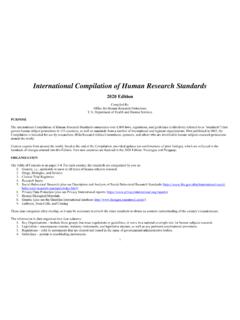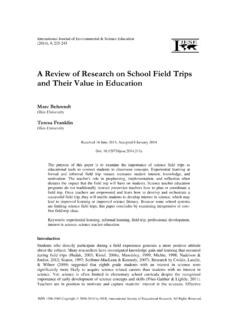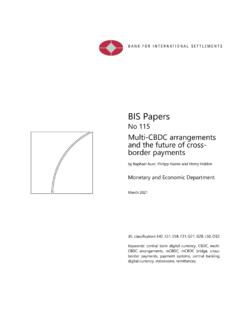Transcription of Provenance Guide - International Foundation for Art …
1 International Foundationfor Art research (IFAR ) Provenance Guide Introduction IFAR Home Page Provenance research was once the province of art scholars dealing primarily with issues of attribution and authenticity. But recent legal claims by heirs of Holocaust victims whose art works were looted or otherwise misappropriated by the Nazis, and claims by foreign source countries for objects they believe were exported in violation of patrimony or export laws, have raised awareness of the need for Provenance research in regard to due diligence in acquiring works of art. Provenance research is often painstaking and not easy to do, and not every work has a discoverable Provenance . What Is Provenance ? Theword Provenance derives fromtheFrenchprovenir meaning tooriginate .Althoughthetermissometimes,incorrectly, used synonymously with provenience, thelatteris an archaeological termreferringtoanartifact sexcavationsiteor findspot,whereas theprovenance ofa work ofartis ahistoricalrecord s Provenance comprises farmore thanitspedigree,however;itis also an accountofchanging artistictastesandcollectingpriorities,a record ofsocial and politicalalliances,and an indicatorofeconomic and marketconditionsinfluencingthesale ortransferofthework provides valuable informationabouttheattributionofan object.
2 Provenanceresearch is by begins witharthistorical resources, Provenance research oftenleads tootherhistoricalor genealogical particularlyevidentin WorldWarII-Eraprovenance one look forwhen conductingprovenance research ? Anideal provenanceprovides a documentaryrecord ofowners names;datesofownership;methodsoftransfer ence, ,or sale througha dealer or auction;and locationswhere thework was kept,fromthe timeofitscreationby ,such complete,unbrokenrecords ofownership are rare,and mostworks ofartcontaingaps in Provenance ;indeed,itis morecommon foran objecttohave an incompleteownership historythana a kind of detective work, Provenance research must be approached with creativity, persistence, attention to detail, and the ability to think outside of the box. And like detective work, Provenance research can be difficult and time-consuming. Often, the difficulties researchers encounter involve the state of extant records. Many archives have suffered damage, destruction, or dispersal due to wars or natural disasters, and the records of smaller or short-lived galleries have not always been preserved.
3 Moreover, private owners may not have saved purchase records, particularly for works of lesser monetary value, and sometimes no records of transfer were created in the first place. Even those records that do exist may not be reliable: they may provide unclear, inadequate, conflicting, or incorrect information. Sometimes records document collections as a whole, rather than individual items within it. Thus, once an item is removed from that collection, it may become difficult or impossible to track its subsequent owners or to identify it as formerly belonging to a particular collector. Tracing an object s ownership history may be further complicated by the variety of means by which the transfer of ownership took place. The object may have been commissioned; or purchased, whether from an exhibition or directly from the artist; or traded by the artist for supplies or another art object; or otherwise transferred by sale, gift, or inheritance, to name a few methods. International Foundationfor Art research (IFAR )2 IFAR Home Page Provenance Guide Complicating the situation even further is the fact that forgers are notorious for creating false documents, thereby intentionally confusing the historical record.
4 Published Provenance information must be critically evaluated and not simply accepted. Each piece of information must be independently corroborated, as incorrect Provenance information is often repeated from one secondary source to the next. If information from a secondary source cannot be confirmed, the Provenance researcher must note this and record the source of the information. Researching Provenance I. Why is Provenance research Important? For Authenticity: Provenance can bolster claims of a work s authenticity. Inventory records of an object s presence in a particular collection or in the artist s studio provide strong evidence of a work s authenticity. As noted, art forgers often falsify Provenance information - forging receipts of sale, ownership marks, dealers records, exhibition labels, and collectors stamps. For this reason, Provenance history is seldom accepted as the sole proof of authenticity. For Valuation: As a factor in establishing authenticity, a complete or distinguished ownership history may have a positive impact on the value of a work of art.
5 Conversely, the absence of a documented Provenance may raise questions about the attribution or authenticity of a work, particularly in the case of an artist whose life and work are well documented. For Ownership: An established Provenance can also help document proof of ownership if legal title is contested. Transaction records and other proofs of sale or transfer of ownership may help determine the legitimacy of a sale or provide a defense in repatriation and restitution claims. In some cases, the presence of a "red-flagged name in the Provenance may indicate that an artwork was stolen, subjected to a forced sale, or otherwise misappropriated during the Nazi Era, thus warranting further research . See the Art Law & Cultural Property section of IFAR s Website for examples of legal cases where Provenance , or lack thereof, was a factor. II. Getting Started An invaluable tool for the new and experienced Provenance researcher alike is The AAM Guide to Provenance research (Nancy Yeide, et al.)
6 ; Washington, : American Association of Museums, 2001). The Guide is divided into two parts. The first explains how to conduct basic Provenance research and also includes appendices with useful bibliographic and archival information. The second part specifically concerns World War II-Era Provenance research , addressing the period between 1933 and 1945. It provides an overview of Provenance issues from this era, as well as an introduction to Nazi-Era collecting activities. It discusses archival resources in the United States and in Europe relating to looting and post-War restitution. Helpful appendices include a bibliography on looting and restitution; lists of names associated with looting during the Nazi Era; a list of wartime and post-War interrogation reports; and codes used by the Einsatzstab Reichsleiter Rosenberg (ERR) in their confiscation of collections. World War II-Era Provenance research will be discussed in Part V of this Guide . The first steps in conducting Provenance research on a specific object are to gather whatever information is available from the object itself, and second, to examine the object file of the institution in which the object is held.
7 The object itself is the most important primary resource and a valuable source of Provenance information. The medium and support of the painting or work on paper must be determined, and the front and back examined for any inscriptions, dates, or other distinctive marks; any alterations to dimensions or changes in support should be noted. International Foundationfor Art research (IFAR )3 IFAR Home Page Provenance Guide Other information can be gleaned from exhibition stickers, seals, dealers and collectors marks, and transport and customs stamps, all of which are often found on the backs of paintings. Useful Provenance information may also be found in institutional and collection records: Registrarial records, which generally contain information on the acquisition, loan, sale, and transport of a work of art Curatorial records, which contain research on and correspondence relating to the work of art Conservation files, which may include X-rays, infrared photographs, and technical and condition reports Other institutional archival material, which may contain additional exhibition history for the object, bequest or gift information, and other donor correspondence beyond that in registrarial files When dealing with institutional records it is crucial to document your sources: Make careful note of the medium and support materials; dimensions; signatures, dates, and inscriptions; current and past attributions.
8 And variations in title Determine whether there have been any significant changes to the condition, support or size of the object Obtain a photograph of both the front and the back of the object so that you can later compare it to illustrations in published sources and other photographic documentation Compile a list of any exhibitions and publications in which the work has appeared Record what is known about the Provenance and include the source of each piece of information; note any gaps in ownership history, as well as any previous version of the object and its Provenance Note the previous owners of the object; you will want to try to contact them or their heirs. Even if they no longer have any records, their recollections could be helpful in adding to the Provenance Make a list of all leads to pursue through library and archival research or written correspondence Once a Provenance has been established, it needs to be recorded. Provenance information should be presented in a clear, organized, and complete manner.
9 A Provenance may be organized in list or in paragraph form, and the sequence of ownership should be given in either chronological or reverse chronological order. Owners should be distinguished from dealers or auction houses. The source of information about each owner or transaction should be documented in footnotes or, if the information is brief, in parentheses. In the format used by many museums and auction houses, punctuation indicates transfers. A semicolon indicates that the work passed directly between two owners, and a period is used to separate two owners if a direct transfer did not occur or is not known to have occurred. The life International Foundationfor Art research (IFAR )4 IFAR Home Page Provenance Guide dates of the owners, if known, are enclosed in brackets or parentheses. Uncertain information is indicated by the terms possibly or probably and explained in footnotes. Dealers, auction houses, or agents are sometimes enclosed in parentheses to distinguish them from private owners.
10 Below is a sample Provenance , in list form, from a major auction house sale of an eighteenth-century Venetian painting: Acquired by Peter William Baker (d. 1815) shortly after he moved into Ranston House, near Blandford, Dorset, in 1779; Thence by descent to Mrs. Gibson Fleming; By whom sold London, Sotheby s, 23 March 1960, lot 36, for 20,000 to Leggatt (the previous lot was its pendant, and sold for 32,000 to L. Koetser); Mrs. Nora Prince-Littler, Chestham Park, Henfield, Sussex; Her deceased sale, London, Christie s, 2 December 1977, lot 73; Anonymous sale ( The Property of a Lady ), London, Christie s, 11 April 1986, lot 54; There purchased by Lord and Lady Forte III. General Provenance research A. Art Historical Resources General Provenance research should begin with library research and the consultation of art historical resources. Library research should stem from the information collected from the object itself (see discussion above) and the institution s files.







